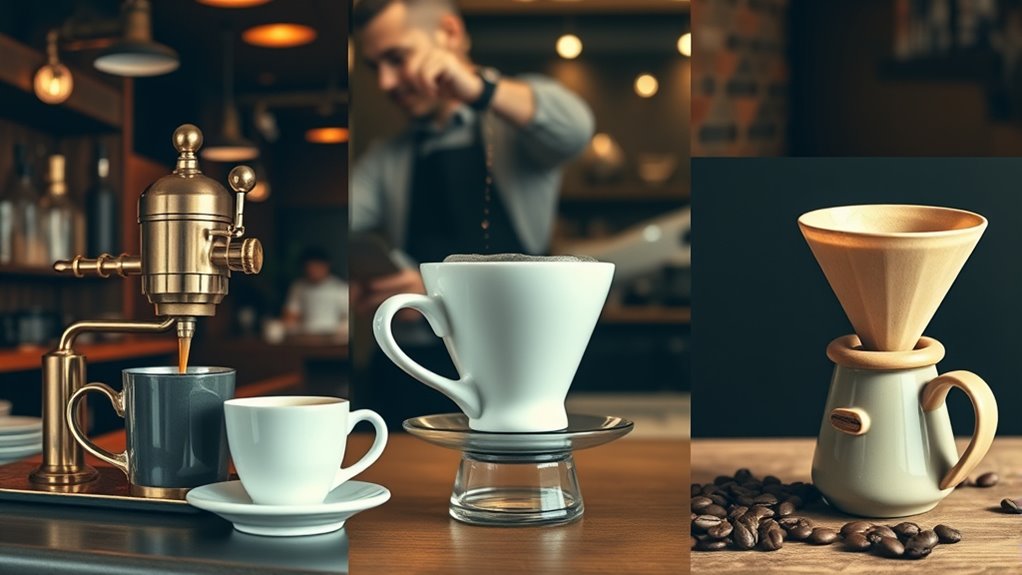You’ve seen coffee evolve through three waves. The first wave focused on mass production and convenience, making coffee widely accessible. The second wave brought an appreciation for quality, flavor, and origin, with specialty shops and craftsmanship becoming popular. The third wave elevates coffee to an art form, emphasizing transparency, sustainability, and refinement in brewing. If you want to explore how each wave shaped today’s coffee culture, there’s more to discover.
Key Takeaways
- The first wave prioritized accessibility and convenience with mass-produced, pre-ground coffee for everyday consumption.
- The second wave shifted focus to specialty beans, brewing techniques, and appreciation of flavor nuances.
- The third wave elevates coffee as an artisanal craft emphasizing transparency, sustainability, and direct relationships with farmers.
- Each wave reflects a progression from basic consumption to a more conscious, quality-driven, and ethically responsible coffee culture.
- Innovative brewing methods and a focus on origin stories define the evolving appreciation of coffee’s complexity across waves.

Coffee has evolved through three distinct waves, each shaping how we enjoy and value this beloved beverage. The first wave was all about accessibility and mass production. During this time, coffee became a household staple, with brands focusing on consistency and convenience. You likely remember grabbing a can of pre-ground coffee from the grocery store, appreciating its affordability and availability. While this wave made coffee a daily routine for many, it often sacrificed quality for volume. Brewing techniques were simple, usually limited to drip machines or instant coffee, which didn’t highlight the complex flavors coffee could offer. This era was about quick caffeine fixes, and the emphasis was on quantity rather than the nuances of taste or origin.
Transitioning into the second wave, the focus shifted toward specialty coffee and a deeper appreciation for the bean itself. You might have started visiting local coffee shops or exploring different roasters, noticing the variety of brewing techniques like pour-over, French press, or AeroPress. This wave emphasized quality over quantity, encouraging consumers to seek out beans with unique flavor profiles and origin stories. Sustainable sourcing became increasingly important, as consumers grew more aware of the environmental and social impact of their coffee choices. Coffee was no longer just a morning necessity; it became a craft, a ritual, and a way to connect with the origins of the beans. Baristas began to master brewing techniques, emphasizing precision and artistry, which elevated the entire experience. The second wave made you more conscious of what you were drinking, inspiring a journey of discovery and appreciation for the nuances in flavor, aroma, and texture. Sustainable sourcing became a key consideration influencing many consumers’ choices. Additionally, the use of specialty grading helped identify higher-quality beans, further enriching the coffee experience.
Now, in the third wave, coffee reaches a level of craftsmanship akin to fine wine or craft beer. You’re encouraged to think of coffee as an artisanal product, with an emphasis on transparency about sustainable sourcing and direct relationships with farmers. This wave champions traceability, so you can know exactly where your beans come from, how they were grown, and under what conditions. Brewing techniques are highly refined, often involving meticulous methods like siphon brewing or advanced pour-over setups that extract the best flavors from each batch. You’re invited to experiment, to refine your palate, and to appreciate the complexities of each cup. The third wave also prioritizes sustainability, ensuring that coffee production respects both the environment and the communities involved. It’s about more than just taste; it’s about ethical consumption and supporting practices that preserve the future of coffee. This evolution invites you to become a more informed consumer, appreciating the artistry, science, and ethics behind every cup you enjoy.
Frequently Asked Questions
How Did Coffee Originally Spread Worldwide?
You might wonder how coffee initially spread worldwide. It all started with the coffee trade, where traders and explorers carried coffee beans across continents, boosting global influence. As Europeans discovered coffee in the Middle East, they brought it home, establishing coffeehouses that became cultural hubs. This trade and cultural exchange propelled coffee’s popularity, transforming it from a local beverage into a global phenomenon with widespread appeal.
What Distinguishes Specialty Coffee From Commercial Blends?
They say “you get what you pay for,” and that’s true with coffee too. Specialty coffee stands out from commercial blends due to strict quality standards and sourcing transparency. You’ll notice better flavor, aroma, and consistency because it’s carefully sourced, processed, and brewed. Unlike mass-produced blends, specialty coffee emphasizes craftsmanship and sustainability, giving you a richer, more authentic experience. It’s all about quality over quantity, making each cup memorable.
How Have Brewing Methods Evolved Across the Waves?
You see brewing methods evolve through innovation and a focus on sustainability. In earlier times, manual techniques like pour-over and French press gained popularity for their quality and control. Technological innovations now introduce espresso machines and automated brewers that enhance consistency and efficiency. Sustainability practices influence equipment design and brewing processes, emphasizing eco-friendly materials and energy-saving features. These advancements help you enjoy better coffee while supporting environmentally responsible choices.
What Role Did Coffeehouses Play in Societal Change?
Think of coffeehouses as hubs of social activism, literary salons, and cultural exchange. You see, they sparked societal change by fostering open discussions, challenging ideas, and supporting reform movements. Through these vibrant spaces, people connected, shared insights, and influenced public opinion. Coffeehouses became catalysts for progress, shaping society’s evolution by encouraging dialogue and community engagement—making them essential engines of social and cultural transformation.
Are There Emerging Trends Beyond the Third Wave?
You might notice emerging trends beyond the third wave, like artisanal roasting and sustainable sourcing. Coffee enthusiasts now prioritize unique, small-batch brews and environmentally friendly practices. You’ll see more focus on transparency in sourcing, connecting consumers directly with farmers. These trends reflect a move towards personalization and responsibility, shaping a new chapter in coffee culture. The industry keeps evolving, emphasizing quality and sustainability to meet modern expectations.
Conclusion
So, savor the story of coffee’s stunning shift from simple sips to sophisticated scenes. You’ve seen the strides of the three waves—starting with standard, then specialty, and finally sustainable. As you sip your favorite brew, remember the revolution’s rhythm, the rise of quality, and the push for purpose. Embrace each wave’s wonder, and let your love for coffee continue to grow. After all, this vibrant voyage is far from finished—your next cup could be part of the ongoing evolution.









